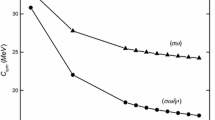Abstract
Based on the semi-classical Thomas-Fermi approximation together with the Skyrme energy-density functional, we study the deformation dependence of symmetry energy coefficients of finite nuclei. The symmetry energy coefficients of nuclei with mass number A = 40, 100, 150, 208 are extracted from two-parameter parabola fitting to the calculated energy per particle. We find that the symmetry energy coefficients decrease with the increase of nuclear quadrupole deformations, which is mainly due to the isospin dependence of the difference between the proton and neutron surface diffuseness. Large deformations of nuclei can cause the change of the symmetry energy coefficient by about 0.5 MeV and the influence of nuclear deformations on the symmetry energy coefficients is more evident for light and intermediate nuclei.
Similar content being viewed by others
References
Gandolfi S, Carlson J, Reddy S, et al. The equation of state of neutron matter, symmetry energy, and neutron star structure. Eur Phys J A, 2014, 50: 10
Zhang Y X, Danielewicz P, Famiano M, et al. The influence of cluster emission and the symmetry energy on neutron-proton spectral double ratios. Phys Lett B, 2008, 664: 145
Tsang M B, Zhang Y X, Danielewicz P, et al. Constraints on the density dependence of the symmetry energy. Phys Rev Lett, 2009, 102: 122701
Li B A, Chen L W, Ko C M. Recent progress and new challenges in isospin physics with heavy-ion reactions. Phys Rep, 2008, 464: 113–281
Li B A, Das C B, Das Gupta S, et al. Momentum dependence of the symmetry potential and nuclear reactions induced by neutron rich nuclei at RIA. Phys Rev C, 2004, 69: 011603
Chen L W, Ko C M, Li B A. Determination of the stiffness of the nuclear symmetry energy from isospin diffusion. Phys Rev Lett, 2005, 94: 032701
Shetty D V, Yennello S J, Souliotis G A. Density dependence of the symmetry energy and the nuclear equation of state: A dynamical and statistical model perspective. Phys Rev C, 2007, 76: 024606
Botvina A S, Lozhkin O V, Trautmann W. Isoscaling in light-ion induced reactions and its statistical interpretation. Phys Rev C, 2002, 65: 044610
Centelles M, Roca-Maza X, Vinas X, et al. Nuclear symmetry energy probed by neutron skin thickness of nuclei. Phys Rev Lett, 2009, 102: 122502
Steiner AW, Gandolfi S. Connecting neutron star observations to three-body forces in neutron matter and to the nuclear symmetry energy. Phys Rev Lett, 2012, 108: 081102
Steiner A W, Prakash M, Lattimer J M, et al. Isospin asymmetry in nuclei and neutron stars. Phys Rep, 2005, 411: 325–375
Dong J, Zuo W, Scheid W. Correlation between α-decay energies of superheavy nuclei involving the effects of symmetry energy. Phys Rev Lett, 2011, 107: 012501
Wang N, Ou L, Liu M. Nuclear symmetry energy from the Fermienergy difference in nuclei. Phys Rev C, 2013, 87: 034327
Wang N, Li T. Shell and isospin effects in nuclear charge radii. Phys Rev C, 2013, 88: 011301(R)
Liu M, Wang N, Li Z X, et al. Nuclear symmetry energy at subnormal densities from measured nuclear masses. Phys Rev C, 2010, 82: 064306
Audi G, Wapstra A H, Thibault C. The AME 2003 atomic mass evaluation (II). Tables, graphs and references. Nucl Phys A, 2003, 729: 337–676
Vautherin D, Brink D M. Hartree-fock calculations with skyrme’s interaction. I. Spherical nuclei. Phys Rev C, 1972, 5: 626
Bartel J, Bencheikh K. Nuclear mean fields through self-consistent semiclassical calculations. Eur Phys J, 2002, 14: 179–190
Brack M, Guet C, Hakanson H B. Selfconsistent semiclassical description of average nuclear properties ł a link between microscopic and macroscopic models. Phys Rep, 1985, 123: 275–364
Liu M, Wang N, Li Z, et al. Applications of Skyrme energy-density functional to fusion reactions spanning the fusion barriers. Nucl Phys A, 2006, 768: 80–98
Bartel J, Quentin P, Brack M, et al. Towards a better parametrisation of Skyrme-like effective forces: A critical study of the SkM force. Nucl Phys A, 1982, 386: 79–100
Chabanat E, Bonche P, Haensel P, et al. A Skyrme parametrization from subnuclear to neutron star densities Part II. Nuclei far from stabilities. Nucl Phys A, 1998, 635: 231–256
Goriely S, Chamel N, Pearson J M. Hartree-Fock-Bogoliubov nuclear mass model with 0.50 MeV accuracy based on standard forms of Skyrme and pairing functionals. Phys Rev C, 2013, 88: 061302(R)
Cwoik S, Dudek J, Nazarewicz W, et al. Single-particle energies, wave functions, quadrupole moments and g-factors in an axially deformed woods-saxon potential with applications to the two-centre-type nuclear problems. Comp Phys Comm, 1987, 46: 379–399
Wang N, Liang Z, Liu M, et al. Mirror nuclei constraint in nuclear mass formula. Phys Rev C, 2010, 82: 044304
Angeli I, Marinova K P, Data At, et al. Table of experimental nuclear ground state charge radii: An update. Data Tables, 2013, 99: 69–95
Danielewicz P, Lee J. Symmetry energy I: Semi-infinite matter. Nucl Phys A, 2009, 818: 36–96
Dutra M, Lourenço O, Sá Martins J S, et al. Skyrme interaction and nuclear matter constraints. Phys Rev C, 2012, 85: 035201
Wang N, Liu M, Wu X Z. Modification of nuclear mass formula by considering isospin effects. Phys Rev C, 2010, 81: 044322
Wang N, Liu M, Wu X Z, et al. Surface diffuseness correction in global mass formula. Phys Lett B, 2014, 734: 215
Author information
Authors and Affiliations
Corresponding author
Rights and permissions
About this article
Cite this article
Mo, Q., Liu, M., Cheng, L. et al. Deformation dependence of symmetry energy coefficients of nuclei. Sci. China Phys. Mech. Astron. 58, 82001 (2015). https://doi.org/10.1007/s11433-015-5667-6
Received:
Accepted:
Published:
DOI: https://doi.org/10.1007/s11433-015-5667-6




